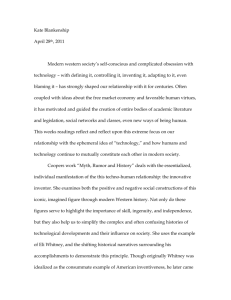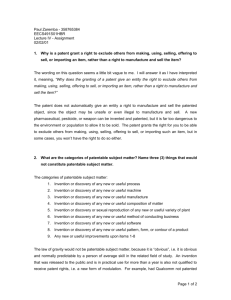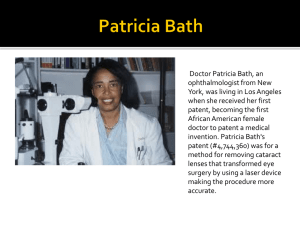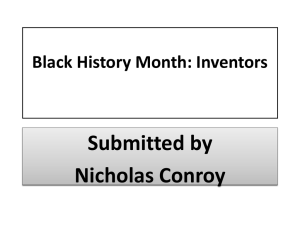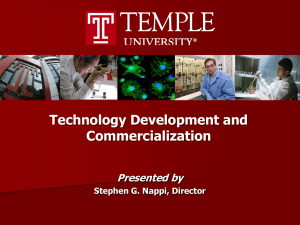Patent Basics
advertisement
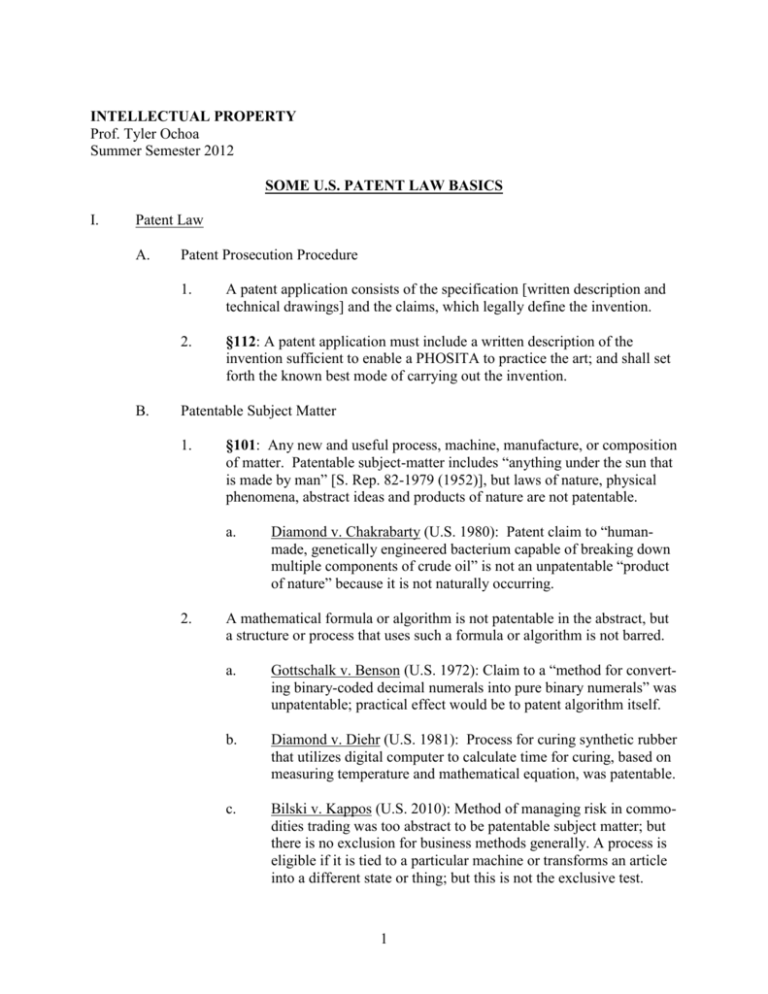
INTELLECTUAL PROPERTY Prof. Tyler Ochoa Summer Semester 2012 SOME U.S. PATENT LAW BASICS I. Patent Law A. B. Patent Prosecution Procedure 1. A patent application consists of the specification [written description and technical drawings] and the claims, which legally define the invention. 2. §112: A patent application must include a written description of the invention sufficient to enable a PHOSITA to practice the art; and shall set forth the known best mode of carrying out the invention. Patentable Subject Matter 1. §101: Any new and useful process, machine, manufacture, or composition of matter. Patentable subject-matter includes “anything under the sun that is made by man” [S. Rep. 82-1979 (1952)], but laws of nature, physical phenomena, abstract ideas and products of nature are not patentable. a. 2. Diamond v. Chakrabarty (U.S. 1980): Patent claim to “humanmade, genetically engineered bacterium capable of breaking down multiple components of crude oil” is not an unpatentable “product of nature” because it is not naturally occurring. A mathematical formula or algorithm is not patentable in the abstract, but a structure or process that uses such a formula or algorithm is not barred. a. Gottschalk v. Benson (U.S. 1972): Claim to a “method for converting binary-coded decimal numerals into pure binary numerals” was unpatentable; practical effect would be to patent algorithm itself. b. Diamond v. Diehr (U.S. 1981): Process for curing synthetic rubber that utilizes digital computer to calculate time for curing, based on measuring temperature and mathematical equation, was patentable. c. Bilski v. Kappos (U.S. 2010): Method of managing risk in commodities trading was too abstract to be patentable subject matter; but there is no exclusion for business methods generally. A process is eligible if it is tied to a particular machine or transforms an article into a different state or thing; but this is not the exclusive test. 1 d. C. Mayo Collaborative Services v. Prometheus Laboratories, Inc. (U.S. 2010): Method of administering a drug and determining the level of metabolite in the blood, which recited that a certain level was too low and a certain level was too high, sets forth a law of nature and is ineligible for a patent absent a specific application. Statutory Requirements for Patent 1. Utility [§101]: Invention must be “useful.” An invention has a wellestablished utility if a PHOSITA would immediately appreciate why the invention is useful, and the utility is specific, substantial and credible. 2. Novelty and Statutory Bar [§102, for appl. filed before Mar. 16, 2013] 3. a. Patent denied if prior to invention by applicant, the invention was known or used by others in the U.S., or was patented or described in a printed publication anywhere in world. b. Patent denied if more than one year before date of filing, the invention was in public use or on sale in the U.S., or was patented or described in a printed publication anywhere in world. c. Patent denied if inventor has abandoned [the right to patent] the invention. [May be either express or implied.] d. Patent denied if invention was the subject of a foreign patent application more than one year before application filed in U.S. and the foreign patent issues before application is filed in U.S. e. Patent denied if invention disclosed in a U.S. patent application pending on date of invention and later either published or granted. f. Patent denied if the applicant did not invent the invention; or g. Patent denied if prior to applicant’s invention, another person made the invention in the U.S., or another person establishes in an interference that s/he made the invention abroad prior to the applicant’s invention; if invention was not abandoned, suppressed, concealed. Novelty and Statutory Bar [§102, for appl. filed on or after Mar. 16, 2013] a. Patent denied if prior to date of filing, the invention was patented, described in a printed publication, or in public use, on sale, or otherwise available to the public; or the invention is describe in a patent or patent application that has an earlier effective filing date. 2 b. 4. D. A disclosure made less than 1 year before the effective filing date is not prior art if made by the inventor, a joint inventor, or another who obtained the subject matter directly from the inventor; or if the matter had previously been publicly disclosed by one of them. Non-Obviousness [§103]: Patent denied if the differences between the claimed invention and the prior art are such that the invention would have been obvious at the time it was made to a PHOSITA. a. KSR Int’l Co. v. Teleflex, Inc. (U.S. 2007): Federal Circuit erred in rigidly applying its “teaching, suggestion, or motivation” test, under which patent is considered obvious only if some suggestion or motivation to combine prior art references can be found in the prior art, the nature of the problem, or knowledge of a PHOSITA. b. [May consider factors such as commercial success of invention, long felt but unsolved needs in the field, failure of others to solve the problem, movement of others in different direction, skepticism regarding the approach taken, acceptance of patent license by competitors, fact that others copied invention instead of alternatives.] Exclusive Rights 1. Exclusive right under §154 is right to exclude others from make, use, offer for sale, or sell the invention [or products made by patented process] in the U.S., or to import the invention or such products into the U.S. a. 2. Duration: Patent lasts for 20 years from the date the patent application was filed. Term may be extended for excessive PTO delay in prosecution [§154] or regulatory delay [§156] Infringement [§271]: a. Whoever without authority makes, uses, offers to sell, or sells any patented invention within U.S., or imports into U.S. any patented invention, during the term of the patent, infringes. b. Whoever actively induces infringement of a patent shall be liable. c. Whoever offers to sell, sells or imports into U.S. a material part of a patented invention, knowing it to be especially made or adapted for use in infringement, and not a staple article or commodity of commerce suitable for substantial non-infringing uses, is liable. 3 f. g. E. Whoever supplies or causes to be supplied in or from the U.S. all or a substantial portion of the components of a patented invention, in such a manner as to actively induce the combination of such components outside the U.S. in a manner that would infringe if it occurred within the U.S., shall be liable as an infringer. (1) Response to Deepsouth Packing Co. v. Laitram Corp. (U.S. 1972): “Making” and “selling” patented invention within U.S. requires completed assembly here; making component parts in U.S. to ship and assemble abroad, did not infringe. (2) Microsoft Corp. v. AT&T Corp. (U.S. 2007): Software can be a “component” of a patented invention when it is a fixed copy embodied in a tangible medium; so supplying a master disk from U.S. to be reproduced and installed abroad, was not supplying “components” from U.S. within §102(f). Whoever imports into the U.S., or offers to sell, sells, or uses within U.S. a product which is made by a process patented in U.S., shall be liable as an infringer, if conduct occurs during patent term. Infringement: Defining the Invention 1. Literal Infringement: Does the accused product or process contain each element of at least one of the claims in the issued patent? 2. Doctrine of Equivalents: Does the accused product or process contain elements identical to or equivalent to each element of one of the claims? 3. Prosecution History Estoppel: If a narrowing amendment was made during prosecution in order to secure the patent, the patent owner may be estopped from invoking the doctrine of equivalents for the element or elements covered by the amendment. 4. Under Festo, an amendment may not reasonably be considered to have surrendered an equivalent if: equivalent was unforeseeable at the time of the amendment; rationale was only tangentially related to the equivalent; some other reason could not reasonably be expected to describe equivalent 5. Defenses to Infringement: Patent invalidity; inequitable conduct; patent misuse; prior use for business method patents [§273(b)]; doctrine of exhaustion (use and sale rights exhausted upon sale of a patented product; repair of a patented item is permitted, but reconstruction is not permitted). 4 II. Trade Secret Law A. Definition 1. B. A trade secret is information, including a formula, pattern, compilation, program, device, method, technique, or process, that a. Derive independent economic value, actual or potential, from not being generally known to, and not being readily ascertainable by proper means by, other persons who can obtain economic value from its disclosure or use; and b. Is the subject of efforts that are reasonable under the circumstances to maintain its secrecy Misappropriation 1. Acquisition of a trade secret of another by a person who knows or has reason to know that it was acquired by improper means; or 2. Disclosure or use of a trade secret of another without express or implied consent, by a person who 3. a. Used improper means to acquire knowledge of the trade secret; or b. At the time of its disclosure or use, knew or had reason to know that his knowledge of the trade secret was derived from a person who used improper means to acquire it, or from a person who had a legal duty to maintain its secrecy or limit its use; or c. Knew or had reason to know that it was a trade secret and that knowledge of it had been acquired by accident or mistake. “Improper means” includes theft, bribery, misrepresentation, breach of a duty to maintain secrecy, or espionage through electronic or other means. 5
![Introduction [max 1 pg]](http://s3.studylib.net/store/data/007168054_1-d63441680c3a2b0b41ae7f89ed2aefb8-300x300.png)

